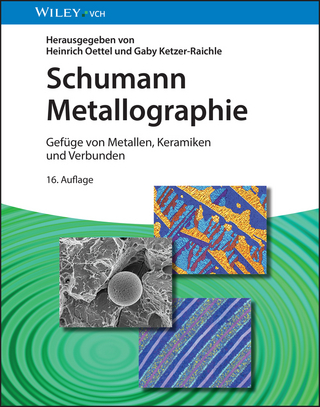
Perovskite Materials and Devices
Wiley-VCH (Verlag)
9783527349241 (ISBN)
- Titel ist leider vergriffen;
keine Neuauflage - Artikel merken
Liming Ding got his PhD from University of Science and Technology of China. He started his research on OSCs and PLEDs in Olle Inganäs Lab in 1998. Later on, he worked at National Center for Polymer Research, Wright-Patterson Air Force Base and Argonne National Lab (USA). He joined Konarka as a Senior Scientist in 2008. In 2010, he joined National Center for Nanoscience and Technology as a full professor. His research focuses on innovative materials and devices. He has published 341 papers on Science, Joule, Energy Environ Sci, Angew Chem, Sci Bull, Nature Comm, Adv Mater, Adv Energy Mater, etc. He is RSC Fellow, the nominator for Xplorer Prize, and the Associate Editors for Science Bulletin and Journal of Semiconductors.
VOLUME 1
1 ALL-INORGANIC CSPBX3 PEROVSKITE SOLAR CELLS
1.1 Introduction
1.2 Basic Properties Of Cspbx3 Materials
1.3 Synthesis Strategies For Boosting Cspbx3 Solar Cells
1.4 Progress And Applications Of High-Performance Cspbx3 Solar Cells
1.5 Potential Application Of Cspbx3
1.6 Summary And Outlook
2 LEAD-FREE HALIDE PEROVSKITES FOR OPTOELECTRONIC APPLICATIONS
2.1 Introduction
2.2 Lead-Free Halide Perovskites
2.3 High-Throughput Screening
2.4 Optoelectronic Applications
2.5 Conclusions And Outlook
2.6 Acknowledgements
3. ELECTRONIC STRUCTURES OF SURFACES AND INTERFACES WITH PEROVSKITES
3.1 Introduction
3.2 Photoelectron Spectroscopy
3.3 Electronic Structures Of Perovskites
3.4. Interface Energetics Between Perovskites And Hole Transport Layers
3.5 Interface Energetics Between Perovskites And Electron Transport Layers
3.6 Perovskite/Electrode Interface In Ctl-Free Devices
3.7 Conclusions And Outlook
4 ION MIGRATION IN HALIDE PEROVSKITES
4.1 Introduction
4.2 General Information About Ion Migration
4.3 Characterization Of Mobile Ions
4.4 Ion Migration Effect Under Light
4.5 Methods To Suppress The Ion Migrations
4.6 Conclusions
5 FUNDAMENTALS AND APPLICATIONS OF DOPING AND ALLOYING IN PEROVSKITE PHOTOVOLTAICS
5.1 Basic Concepts And Principles Of Doping And Alloying
5.2 Applications Of Doping And Alloying In Perovskite Layers
5.3 Applications Of Doping In Charge Transporting Layers
5.4 Conclusion And Perspective
6 MOLECULAR ENGINEERING OF ORGANIC CHARGE TRANSPORT MATERIALS FOR EFFICIENT PEROVSKITE SOLAR CELLS
6.1 Introduction
6.2 Hole Transport Material
6.3 Electron Transport Materials
6.4 Perspective
7 PEROVSKITE SINGLE-CRYSTAL OPTOELECTRONIC DEVICES
7.1 Introduction
7.2. The Properties For Perovskite Single Crystal
7.3. Defect Properties Of Halide Perovskite Single Crystals
7.4. The Growth Of Halide Perovskite Single Crystals
7.5. Perovskite Single-Crystal Optoelectronic Device
7.6. Challenges And Outlook
8 QUASI-2D PEROVSKITE FOR PHOTOVOLTAIC APPLICATIONS
8.1 Introduction
8.2 Structure Of Quasi-2d Perovskite
8.3. Stability Of Quasi-2d Perovskite
8.4. Carrier Transport Dynamics Of Quasi-2d Perovskite
8.5. 2d/3d Hybrid Structure Perovskite
8.6. Conclusions And Outlook
9 HALIDE PEROVSKITE NANOCRYSTALS AND APPLICATIONS TO SOLAR CELLS
9.1 Introduction
9.2 Synthesis Methods of Halide Perovskite Nanocrystals
9.3 Photophysics of Halide Perovskite Nanocrystals
9.4 Surface Passivation of Halide Perovskite Nanocrystals
9.5 Application of Halide Perovskite Nanocrystals To Solar Cells
9.6 Conclusion and Outlook
10 PEROVSKITE-BASED TANDEM SOLAR CELLS
10.1 Introduction And Motivation
10.2 Perovskite/C-Si Tandem Solar Cells (Tscs)
10.3 Perovskite/Opv Tandem Solar Cells (Tscs)
10.4 All-Perovskite Tandem Solar Cells
10.5 Strategies To Improve Performance
10.6 Emergence Of Multi-Junction Perovskite-Based Tandems
10.7 Summary
VOLUME 2
11. PEROVSKITE/ORGANIC INTEGRATED DEVICES
11.1 Introduction
11.2 Perovskite/Organic Integrated Solar Cells
11.3 Perovskite/Organic Integrated Photodetectors
11.4 Perovskite/Organic Tandem Solar Cells
11.5 Outlook
12. SEMITRANSPARENT PEROVSKITES FOR SOLAR CELLS AND SMART WINDOWS
12.1 Introduction
12.2 Semitransparent Perovskites
12.3 Semitransparent Electrodes
12.4 Perovskite For Smart Windows
12.5 Summary And Outlook
13. FLEXIBLE OPTOELECTRONIC DEVICES BASED ON HYBRID PEROVSKITES
13.1. Introduction
13.2. Flexible Perovskite Solar Cells
13.3. Flexible Perovskite Photodetectors
13.4 Other Optoelectronic Applications
13.5. Conclusion And Outlook
14. LARGE-AREA PEROVSKITE OPTOELECTRONIC DEVICES AND THE FABRICATION TECHNIQUES
14.1. Introduction
14.2. Large-Area Perovskite Solar Cells And Modules
14.3. Large-Area Perovskite Optoelectronic Devices Beyond Solar Cells
14.4. Industrial Processes For Deposition And Patterning
14.5. Cost And Life Cycle Assessment For Perovskite Solar Cells
14.6. Conclusions And Outlook
15. STABILITY OF PEROVSKITE MATERIALS AND DEVICES
15.1 Introduction
15.2 Thermal Stability
15.3 Oxygen Stability
15.4 Moisture Stability
15.5 Light Stability
15.6 Electrical Stability
15.7 Comprehensive Stability
16. METAL-HALIDE PEROVSKITES FOR COHERENT LIGHT EMISSION
16.1 Introduction
16.2 Development History Of Organic-Inorganic Perovskite Lasers
16.3 Coherent Light Emission From Other Perovskites
16.4 Nonlinear Effect In Coherent Light Emission
16.5 Small Lasers
16.6 Encapsulated Lasers
16.7 Integrated Lasers
16.8 Post-Synthetically Tunable Lasers
16.9 Laser Array
16.10 Novel Lasers
16.11 Conclusion And Outlook
17. PEROVSKITE LIGHT-EMITTING DIODES
17.1 Introduction
17.2 Bandgap Engineering For Wavelength-Tunable Perovskite Leds
17.3 Low-Dimensionality Perovskites Light-Emitting Diodes
17.4 Metal Halide Perovskite Nanocrystal Light-Emitting Diodes
17.5 Fundamental Device Engineering Strategy For High-Performance Perovskite Light-Emitting Diodes
17.6 Conclusion And Outlook
18. NOVEL ELECTRONIC DEVICES BASED ON PEROVSKITE MATERIALS
18.1 Introduction
18.2 Resistive Switching Devices
18.3 Halide Vacancies Migration
18.4 Other Mechanisms
18.5 Phototunable Resistive Switching Devices
18.6 Transistors Based On Halide Perovskites
18.7 Ferroelectrics
18.8 Spin Polarization
18.9 Neuromorphic Devices
18.10 Conclusion And Outlook
19. LEAD, AN OBSTACLE FOR INSTALLING PEROVSKITE DEVICES
19.1 Introduction
19.2 Influence Of Encapsulation On Lead Leaking
19.3 Advantages Of Constructing Perovskite Solar Arrays On Removing Pb In Our Environment
19.4 Possible New Rules About Perovskite Solar Arrays Installations
19.5 Summary
| Erscheinungsdatum | 28.06.2022 |
|---|---|
| Verlagsort | Weinheim |
| Sprache | englisch |
| Maße | 170 x 244 mm |
| Gewicht | 1646 g |
| Themenwelt | Naturwissenschaften ► Chemie |
| Technik ► Elektrotechnik / Energietechnik | |
| Technik ► Maschinenbau | |
| Schlagworte | Chemie • Chemistry • Components & Devices • Electrical & Electronics Engineering • Elektrotechnik u. Elektronik • Festkörperchemie • Komponenten u. Bauelemente • Materialeigenschaften • Materials Science • Materialwissenschaften • Perowskit • properties of materials • solid state chemistry |
| ISBN-13 | 9783527349241 / 9783527349241 |
| Zustand | Neuware |
| Informationen gemäß Produktsicherheitsverordnung (GPSR) | |
| Haben Sie eine Frage zum Produkt? |
aus dem Bereich


